
…here’s how to know if you have stomach ulcers — and what you can do about it…
—-Important Message From Our Sponsor—-
“The 2pm refresher” — energizes men better than strong coffee
Rather than a short jolt of caffeine, wouldn’t you prefer an unlimited, natural source of energy anytime you need it?
I’m not talking about that brief ‘wired’ feeling you get from drinking coffee or espresso…
I’m talking about the type of pure natural energy that children run on.
———-
Most men may have stomach ulcers but not know it
Scientific articles demonstrating that stress causes gastric ulcers have been published since the 1950s, yet the association was suspected by the public even before then.
And it has been verified many times over.
BUT few people today realize that ulcers are actually caused by free radicals – not by “increased stomach acid.”
And even fewer people know HOW stress is involved in causing ulcers.
“Although vagal stimulation during stress is expected to increase gastric acid secretion, the role of acidity in stress-ulcer formation is insignificant, as stress itself reduces gastric secretion and acidity.” (Das, 1996)
It is likely true that most people are satisfied with simply KNOWING that stress literally causes ulcers…
But knowing the underlying mechanism translates into knowing precisely how to avoid them.
Or, that is, knowing the mechanism reveals how to avoid ulcers beyond simply avoiding stress….
Because stress is truly hard to avoid in our modern capitalist societies.
And physiological stress, as defined by scientists, can even occur in non-intuitive ways such as through cold exposure or hypoxia.
All forms of physiological stress converge at one event: the release of catecholamines.
Thankfully, enough experiments have been performed to show that simple dietary modifications can make a person ulcer-proof…even in the face of punishing stress.
Avoiding ulcers means avoiding free radicals… And avoiding free radicals means restricting iron.
It was demonstrated decades ago that enough vitamin E can make rats ulcer-proof (Harris, 1947).
Stress liberates free iron inside the body, thereby increasing free radicals…
Yet these can be squelched by scavengers that can safely store an extra electron.
And check this out:
The fact that free radicals are produced by excessive iron is almost certainly why blood donors have lower cancer incidence than the norm, even after studies control for the “healthy donor effects.”
“A dose-dependent decreasing risk of cancers of the liver, lung, colon, stomach, and esophagus – which are suggested to be promoted by iron overload – was observed among men who donated blood 3-7 years earlier.” (Edgren, 2008)
Stress ulcers can actually be produced on an empty stomach, so ingesting food is not required.
Ulcers are often formed internally, irrespective of the stomach lining’s integrity – they can originate from the vasculature (vascular system) of the stomach.
The free radical etiology is established science now. But the idea does take some time getting used to…
And perhaps that’s on account of all the television commercials that advertise over-the-counter antacids and proton pump inhibitors (PPIs).
Americans have been TV-brainwashed for decades into thinking “stomach acid” is the prime agent in ulcers.
Yet the “strict acid requirement” has been proven false ad infinitum…
In fact, to become ulcer-proof all we need to do is avoid iron and consume vitamin E.

Although free radicals had been known to cause ulcers before this, the article above is one of the first to specifically implicate the hydroxyl radical (•OH).
(Hydroxyl radicals are occasionally produced as a byproduct of immune action.)
This was demonstrated by inducing stress ulcers in rats after giving some of the rats, but not all of them, specific •OH-scavengers such as dimethyl sulfoxide and sodium benzoate.
Dimethyl sulfoxide safely binds the hydroxyl radical, forming methanesulfinic acid and the less reactive methane radical:

There are many ways to induce stress ulcers but the researchers chose cold-restraint stress for these rats.
This process involved keeping the rats tied down for two hours at 4° Celsius.
A few of the other ways shown to induce stress ulcers experimentally include water-immersion restraint stress, burn-shock stress, hypoxia, and ischemia-reperfusion.
The researchers also used some general antioxidants, such as vitamin E and glutathione, and then measured lipid peroxidation products afterwards.
As expected, they found that the antioxidants decreased lipid peroxidation…
But perhaps surprising was the concurrent reduction in ulcers:
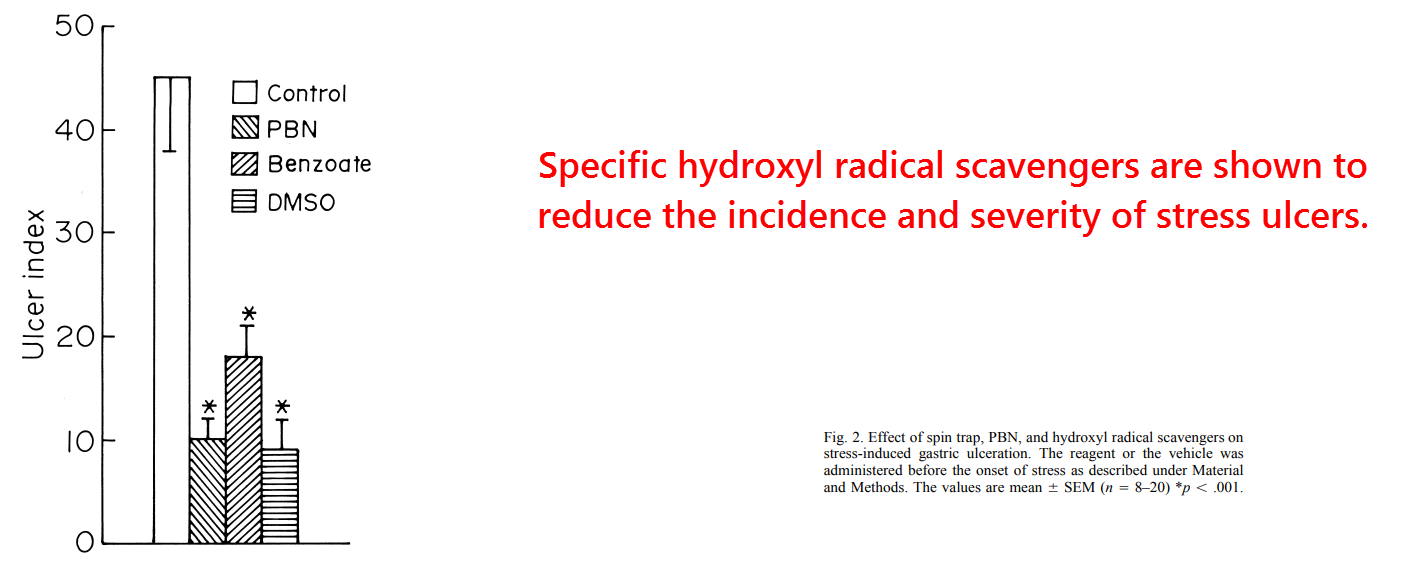
Pertaining to the data on lipid peroxidation, they had calculated glutathione to reduce it by 42% and vitamin E by 28%.
But the thing shown to reduce lipid peroxidation even more than vitamin E wasn’t an antioxidant in the general sense, but an iron chelator…
Dexferrioxamine reduced lipid peroxidation by 32%.
“On the other hand, desferrioxamine, a nontoxic metal ion chelator, has a tremendous potential to control this •OH-mediated gastric damage by stress.” (Das, 1996)
This is intuitive because free iron (Fe2+) and hydrogen peroxide (H2O2) catalyze the formation of hydroxyl radicals (•OH) through what are called Haber-Weiss and Fenton reactions.
Fe2+ + H2O2 ⟶ Fe3+ + OH− + •OH
I’ll explain exactly how and why iron is released through stress shortly…
But first, it’s important to know that free radicals can definitely cause ulcers.
Being certain of this fact has many implications for treatment, such as abandoning PPIss and antacids in favor of natural antioxidants and iron restriction.
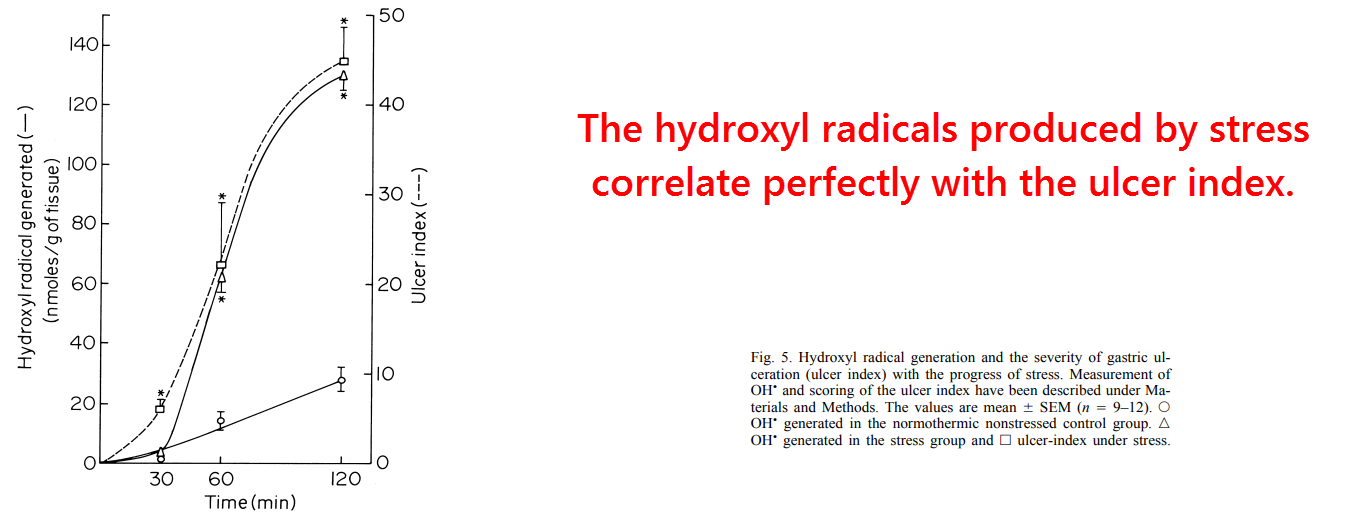
These rats had actually fasted for 40 hours beforehand, so we can eliminate any notion of food playing a role in their stress ulceration.
Experimental proof in support of the free radical etiology isn’t limited solely to rodents either, as these trends are also reported in humans with ulcers:

Upon coming across the early Dipak Das articles implicating free radicals as being involved, researchers from India replicated the rat experiment.
But they also took biopsies from humans.
They confirmed the results of the rodent study by showing a 45% increase in lipid peroxidation, a 145% increase in superoxide dismutase, and a 39% decrease in catalase under stress.
(Catalase is an enzyme that protects cells from oxidative damage.)
This aberration in enzyme activity is a veritable recipe for free radical production.
The enzyme superoxide dismutase is transcribed through the transcription factor NF-κB upon sensing hydrogen peroxide.
And catalase, whose job is to safely break down hydrogen peroxide, is physically destroyed by hydroxyl radicals.
So the increase in catalase often found in superoxide dismutase is a normal protective response by the cell.
But the decrease in catalase occurs through direct free radical damage.
These researchers also showed that the same enzyme changes that are consistently shown in rats also occur in humans:
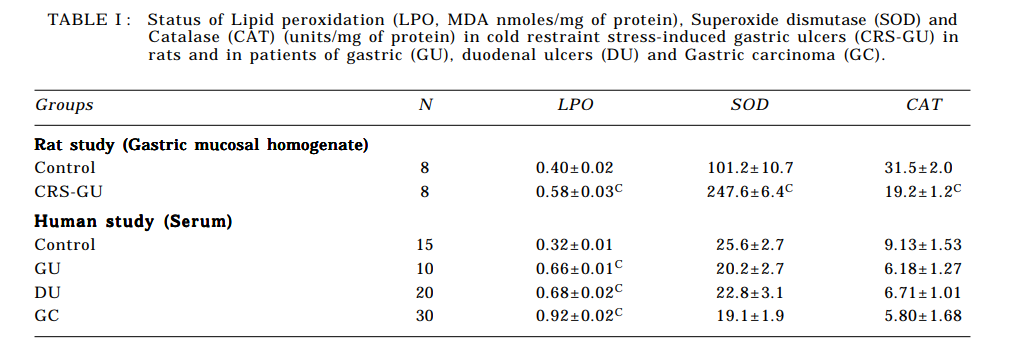
They investigated four groups of human biopsies.
- Control group
- 10 patients with gastric ulcer (GU)
- 20 patients with duodenal ulcer (DU)
- 30 patients with gastric cancer (GC)
In all cases of ulcers, catalase activity was decreased while lipid peroxidation was increased…
And these are assumed to be causally related.
A reduction of catalase allows hydrogen peroxide to build up.
And upon interacting with free iron, that leads to damaging hydroxyl radicals.
Bacteria generally lack catalase, which is why they are more sensitive to hydrogen peroxide than human cells are.
So these patients were likely high in iron and low in vitamin E.
These two dietary factors are perhaps the reason why switching from a refined rice diet to an unrefined wheat diet eliminates ulcers in 86% of people who have them (Malhotra, 1978).
Refined grains have negligible amounts of vitamin E, and reduced iron is often added.
“The incidence of duodenal ulcer is high in the [white] rice-eating areas of India, Pakistan, and Bangladesh, and low in those areas of the Punjab and Rajasthan where the staple diet is unrefined wheat in the form of chapattis.” (Malhotra, 1978)
And there’s even more data proving this in humans, some of which even predates the early `090s studies by Dipak Das.
A short publication in the austere journal The Lancet provides some of the initial proof of free radicals being involved in ulcers…and this was in humans:

These stress ulcers had actually been caused by trauma before admission, the trauma usually comprising multiple fractures of the legs and/or hips.
(I can only assume these cases were mostly the result of traffic accidents.)
The treatment group had been given the •OH-scavenger dimethyl sulfoxide and also allopurinol, an inhibitor of xanthine oxidase.
Xanthine oxidase is classically thought to cause free radicals under stress (but more about that later).
Of the 40 treated patients and 42 controls, they found stress ulcers in 2.5% of the former group (treated) and 23.8% of the latter (controls).
“1 patient in the treatment group and 10 controls had stress injury of the gastric mucosa 2-4 days after admission… The results suggest that oxygen-derived free radicals are directly implicated in stress-induced acute gastric mucosal injury and that removing them protects against this injury.” (Salim, 1989)
Now, dimethyl sulfoxide is somewhat unnatural (though it is found in garlic in low amounts), so I wouldn’t recommend supplementing it for that reason.
Natural antioxidants such as vitamin E and selenocysteine should be just as reliable.
Selenocysteine is needed to form glutathione peroxidase, a selenoenzyme that safely transforms hydrogen peroxide into water before it can become hydroxyl radicals.
So even in the event of low catalase activity, hydrogen peroxide can be safely eliminated by glutathione peroxidase – because the enzyme has the same function.
Whether stress is induced by physical trauma, cold restraint, water-immersion restraint, burn shock, hypoxia, or ischemia-reperfusion, the result is free radicals and ulcers in all cases.
And as alluded to above, all forms of physiological stress converge at just one event…the release of catecholamines.
And catecholamines, believe it or not, have been shown to cause the direct release of iron from ferritin – its main binding protein:

This study was undertaken to better understand the roles of catecholamines and xanthine oxidase on the release of iron from ferritin.
They confirmed previous studies by showing that 6-hydroxydopamine (A.K.A. oxidopamine or 6-OHDA) releases iron.
(Oxidopamine is a neurotoxic synthetic compound that researchers use to selectively destroy noradrenergic and dopaminergic and neurons in the brain.)
The researchers also showed that epinephrine, norepinephrine, and isoproterenol will do the same.
They also tried metaproterenol and phenylephrine, two pharmaceutical adrenergic agents that lack a true catechol ring.
And these two did not work, proving that the redox properties of the catechol ring are essential here.
Catechols are quite effective electron donors, transforming to their o-semiquinone and ortho-quinone forms while sequentially losing electrons.
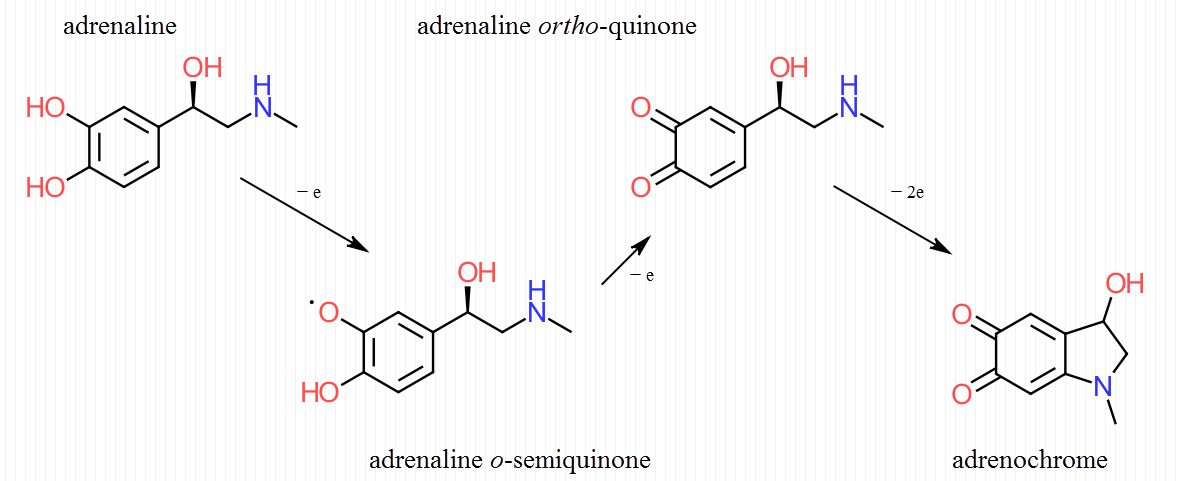
The specific effects of catechols could be because iron atoms require one electron before they can be released from ferritin.
Ferritin only avidly binds ferric iron (Fe3+). Yet when it is reduced down to the ferrous state (Fe2+), it loses affinity and floats away.
They also showed that iron liberated from ferritin correlates with increased free radical production, perhaps the main reason why stress can lead to oxidative damage.
The graph showing iron release (left) is nearly identical to the one depicting radical formation (left):
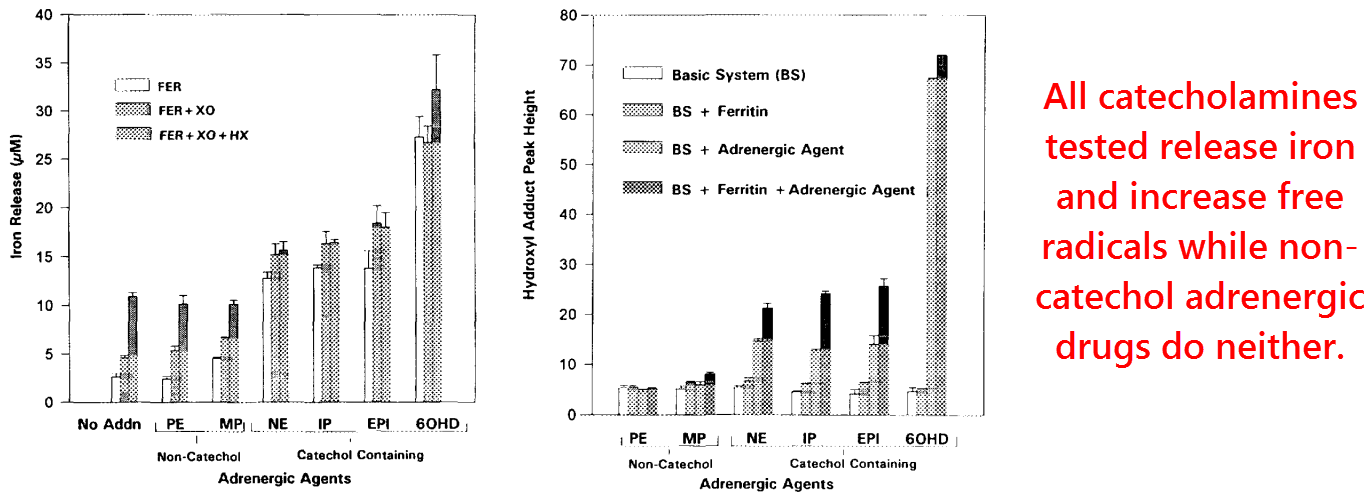
This could be an evolutionary mechanism to create more hemoglobin, which does need a considerable amount of iron.
Hemoglobin is indispensable for oxygen transport, and one of the main functions of catecholamines is to increase this.
Although catecholamines are found to actually decrease blood flow to certain areas, and thus oxygen, they do this to divert more oxygen towards the muscles and the heart.
The net effect of catecholamines is to increase oxygen consumption.
These results suggest that people with iron overload would be particularly sensitive to stress-induced free radicals, ulcers, and even cancer – which is in fact a classic finding.
Vitamin E would most certainly protect the cell from damage, but selenocysteine could prevent free radicals from forming in the first place.
These researchers also showed that the addition of catalase, which breaks down hydrogen peroxide, would almost completely eliminate hydroxyl radical (•OH) formation:
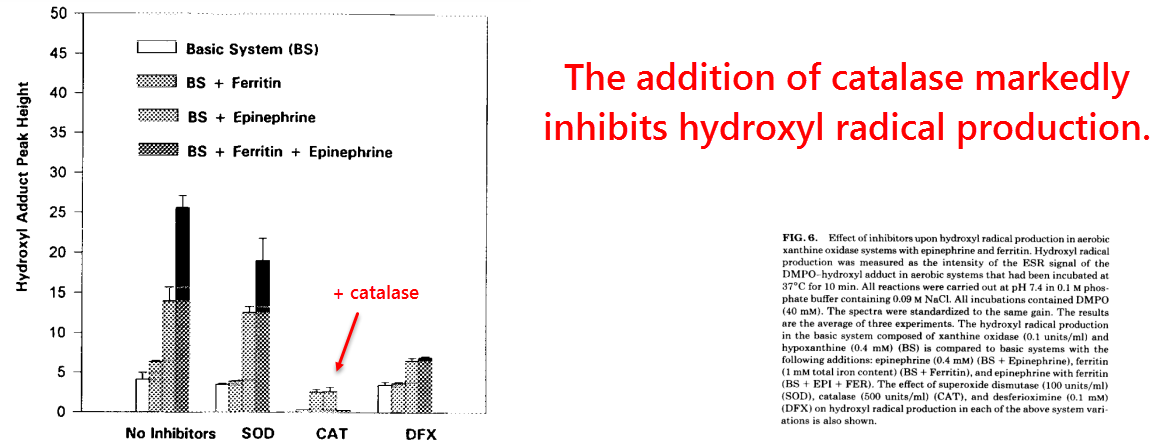
As we already saw, catalase serves the very same function as glutathione peroxidase, an enzyme that requires selenocysteine.
So taking selenized yeast should help prevent stress ulcers by lowering hydrogen peroxide.
Free radical production was also prevented in this study by desferrioxamine (DFX), an iron chelator. So simple iron restriction should help.
Reduced iron is often added to breakfast cereals, refined grains, and multivitamin-multimineral supplements.
Mixed tocopherols are the preferred form of vitamin E, and this is because they also contain gamma-tocopherol.
Supplementing with pure alpha-tocopherol has been shown to deplete the body of gamma-tocopherol through displacement, and only the latter is capable of scavenging nitric oxide.
In summary, the following can help protect against the formation of free radicals and protect against ulcers:
- Selenized yeast
- Iron restriction
- Vitamin E in the form of mixed tocopherols
- Avoiding stress
—-Important Message for Men Who Love Sex—-
Something you can do by yourself to improve “rockiness” and feel more pleasure
One of my greatest discoveries to date is this little-known trick that makes sex even more pleasurable…
I found that guys can do this trick on their own to experience amazing pleasure and increase their staying power and their “rockiness.
I call it “Nirvana Sex” because it makes sex 100 times more pleasurable than ever before, so it’s this deeply erotic experience every single time you do it.
It works by developing so many more connections between the nerves in your male member and your brain…
…and this increases the pleasure signals x100.
After doing Nirvana Sex by yourself, you’ll be able to go for hours when you’re with a woman, and you’ll start feeling whole-body waves of orgasmic bliss…

Discover how to have Nirvana Sex and get rockier and feel more pleasure
———-
